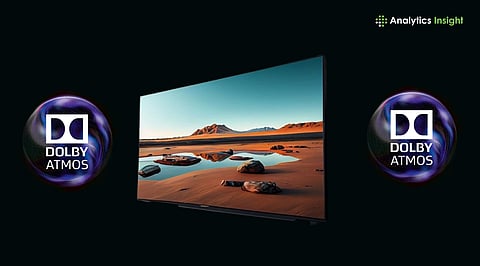

Dolby Vision and Dolby Atmos enhance picture and sound quality, offering a cinematic experience at home.
Setting up these technologies requires compatible devices and adjusting TV settings.
Follow this guide for an easy and immersive setup, bringing professional-grade visuals and audio to any living room.
Home entertainment technology has rapidly evolved, offering viewers an experience that goes far beyond standard television. Dolby Vision and Dolby Atmos are at the forefront of such technologies, transforming how movies, shows, and games are seen and heard. These technologies combine exceptional picture clarity with immersive audio, delivering a cinematography experience at home.
Imagine watching a movie where every color bursts with lifelike brilliance, and every sound seems to flow around the room if inside a theater. This is the effect of Dolby Vision and Dolby Atmos: a revolution that transforms ordinary visuals into an enthralling, interactive multi-sensory experience. By following some simple setup instructions, you can transform a modern TV into a premium entertainment hub.
To experience Dolby Vision, the first step is ensuring your TV supports this HDR technology. Most 4K HDR TVs from brands like LG, Samsung, and Sony now include Dolby Vision compatibility.
Check the TV’s specifications and settings menu to confirm.
Once verified, make sure the content that is being streamed or played (from services like Netflix, Apple TV+, and Amazon Prime Video) also supports Dolby Vision.
Then connect them using a high-speed HDMI cable.
Also Read: Best Dolby Audio Soundbars in 2025
To set up Dolby Atmos on TV, you must have a proper sound system or a soundbar that supports this feature. Brands such as Sonos, Bose, and LG have all introduced several new soundbars that incorporate Dolby Atmos technology.
Make sure your television is equipped with the proper HDMI ARC or eARC port for a straightforward connection of the soundbar.
After connecting, access the audio settings of the TV and select Dolby Atmos, or another 3D audio option like Bitstream, if available.
Then, play the Atmos-supported content either from a streaming service or an external device.
It is important to verify that your streaming service also offers Dolby Atmos; platforms such as Disney+ and Netflix have a growing library of Atmos-enabled content.
Once you have linked the appropriate devices, go to the settings and adjust them to improve the quality of Dolby Vision and Dolby Atmos. For the best visual quality, the TV should be set in the "HDR" or "Dolby Vision" mode. Turn off motion smoothing, as this might lower the quality of Dolby Vision content. If the TV offers this option, then select "Dolby Atmos" for audio and experience the complete surround sound.
Leading TV manufacturers like LG, Samsung, and Sony have integrated Dolby Vision and Dolby Atmos into their finest 4k models. Dolby Vision and Atmos have also gained support among the most futuristic streaming devices like Apple TV 4K, Roku Ultra, and Amazon Fire TV 4K.
For sound, premium soundbars like the Sonos Arc or the Bose Soundbar 700 are popular choices for home theater setups. It's best to check that all the devices in the system are compatible to avoid problems.
Also Read: Boult’s New Boomx Tech: How Does It Compare to Dolby Atmos?
Dolby Vision and Dolby Atmos are the gold standard for home entertainment. Compared to older models, which offered basic 4K and stereo sound, these technologies provide a far superior experience.
The precision of color and brightness in Dolby Vision surpasses the HDR format, and Dolby Atmos provides sound in three dimensions instead of regular surround sound, thus creating an immersive audio environment.
Users who want to upgrade their home theater setup will be excited by these features, as they give the most sophisticated and movie-like experience. The transition from just watching TV to having an immersive entertainment experience is quick and easy at the same time. By investing in compatible devices and following the simple setup steps, users can enjoy a truly premium experience that rivals cinema quality.
1. Can I add Dolby Atmos to my TV?
If your TV doesn't support ARC/eARC, you can still enjoy the crystal-clear audio of your soundbar enabled with Dolby Atmos. To get started, just make sure your soundbar has at least one HDMI input and a dedicated HDMI output.
2. Can all TVs play Dolby Atmos?
Some TVs do not support Dolby Atmos audio even if the source device (e.g., Roku Ultra) does. In most cases, the TV will re-encode the audio to Dolby Digital 5.1.
3. How do I know if my TV has Dolby Vision?
To check if your TV supports Dolby Vision, look for the official Dolby Vision badge on your TV or in its user manual, check the manufacturer's website by searching your TV's brand and model number, or browse the product's specifications at the retailer where you purchased it. Major brands like LG, Sony, TCL, Hisense, and others offer Dolby Vision-enabled TVs.
4. What is the best HDMI cable for Dolby Atmos?
HDMI 2.1 is the latest version. It allows streaming of advanced surround sound formats like Dolby Atmos and DTS:X and supports 8K video. Austere's VII Series 8K HDMI cables use innovative technologies and materials to ensure maximum speed, reliability, and compatibility.
5. How many speakers are needed for Dolby Atmos?
A minimum of seven speakers (a 5.1.2 setup) is recommended for Dolby Atmos, consisting of five floor-level speakers, one subwoofer, and two overhead or upward-firing speakers. However, a 7.1.4 setup with four overhead speakers provides a more immersive "dome of sound" and is the preferred minimum for a truly premium Dolby Atmos experience.
